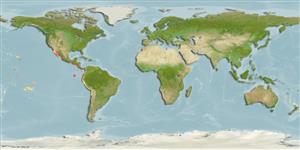>
Callionymiformes (Dragonets) >
Callionymidae (Dragonets)
Etymology: Synchiropus: Greek, syn, symphysis = grown together + Greek, cheir = hand + Greek, pous = foot (Ref. 45335).
More on author: Garman.
Environment: milieu / climate zone / depth range / distribution range
Ecologia
marino demersale; distribuzione batimetrica 12 - 232 m (Ref. 58018). Tropical
Eastern Pacific: Costa Rica to Talara, Peru and the Cocos and Galapagos islands; a disjunct population at Gorda Banks, off Cabo San Lucas, Baja California.
Size / Peso / Age
Maturity: Lm ? range ? - ? cm
Max length : 16.7 cm TL maschio/sesso non determinato; (Ref. 86316)
Prefers sand and mud habitats, and to a lesser degree, areas of coral rubble. May be encountered by divers in sandy patches among stands of coral or rocky reefs. Feeds on small benthic invertebrates (Ref. 28023). Oviparous (Ref. 56078).
Life cycle and mating behavior
Maturities | Riproduzione | Spawnings | Egg(s) | Fecundities | Larve
Eschmeyer, W.N. (ed.), 1998. Catalog of fishes. Special Publication, California Academy of Sciences, San Francisco. 3 vols. 2905 p. (Ref. 26282)
IUCN Red List Status (Ref. 130435)
Threat to humans
Harmless
Human uses
Strumenti
Special reports
Download XML
Fonti Internet
Estimates based on models
Preferred temperature (Ref.
123201): 14.7 - 26, mean 17.1 °C (based on 54 cells).
Phylogenetic diversity index (Ref.
82804): PD
50 = 0.5000 [Uniqueness, from 0.5 = low to 2.0 = high].
Bayesian length-weight: a=0.00933 (0.00492 - 0.01771), b=2.83 (2.67 - 2.99), in cm total length, based on LWR estimates for this species & (Sub)family-body (Ref.
93245).
Trophic level (Ref.
69278): 3.5 ±0.37 se; based on food items.
Resilienza (Ref.
120179): Alto, tempo minimo di raddoppiamento della popolazione meno di 15 mesi (Preliminary K or Fecundity.).
Fishing Vulnerability (Ref.
59153): Low vulnerability (10 of 100).
